Have you discovered The Alexandria Project?
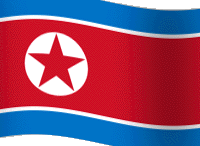
In an interesting example of life imitating art, the events unfolding in North Korea this week are directly paralleling those that I envisioned in my book, The Alexandria Project. Specifically, if you’ve been watching the news, the North Koreans intend to launch a new, three stage missile which they say is intended to put a communications satellite into orbit.
This is placing other countries in an uncomfortable position, as the same launch system, if it proves to be viable, could be used to deliver nuclear weapons to distant targets – including the United States.
North Korea’s missile program places other nations in the same quandary that Iran’s neighbors face in connection with that country’s nuclear development program. Should they act now to prevent Iran from possibly earning a place in the nuclear weapons club, or just wait and see?
Given the similarities between current fact and my recent fiction, I’ve decided to post a few excerpts from The Alexandria Project below to give you an idea what life inside the White House might be like right now. I hope you enjoy them.
– 0000 – 0001 – 0010 – 0011 – 0100 – 0011 – 0010 – 0001 – 0000 –
Alexandria Project, Chapter 20: Does the Dear Leader have a Rocket in his Pocket, or is he Just Happy to See Us?
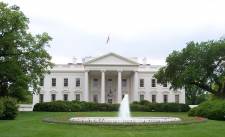 The President of the United States was treating himself to an early breakfast of bacon and eggs. And why not? If a Commander-in-Chief couldn’t ignore his personal physician’s orders on his seventieth birthday, why bother to have the job at all?
The President of the United States was treating himself to an early breakfast of bacon and eggs. And why not? If a Commander-in-Chief couldn’t ignore his personal physician’s orders on his seventieth birthday, why bother to have the job at all?
“Ready, Mr. President?”
“Go for it, Harry.”
Adlai Stevenson Harrison was the President’s Director of National Intelligence. He was also one of his oldest and best friends, and one of the few advisors the President invited to visit him in the family’s private quarters upstairs at the White House.The President put on his reading glasses as Harrison handed him the Daily Brief he had completed a half hour earlier.
“Hmm. I see you’ve moved Korea to the top of the list. What’s new since yesterday? Have they gone and sunk another South Korean boat?”
“No, nothing that dramatic. But we’re worried that this time the North might push the envelope a lot farther than usual.”
“Because?” The President sampled his eggs with appreciation.
“We’re receiving reports that last year’s crop failures were far worse than previously thought. The winter’s less than half over, and we estimate that famine conditions will prevail over more than 75% of the country by February. With Kim Jong-Il looking more frail each time he pops up, we’re beginning to worry that the inner circle may decide they need a more dramatic international crisis than usual to distract the population.”
The President put down his fork and sat back with his coffee.
“’May decide?’ According to the DB you handed me, Jong-Il is saying he’s going to turn Washington instead of Seattle into a “Sea of Fire” if we back the South on that last sinking. What’s the latest on their missile program?”
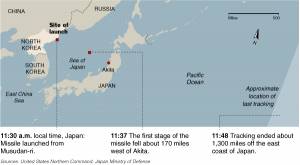 “The truth is, there are some new developments we’re watching closely. You’ll recall that the North tried to launch a satellite back in April of 2009. They used a three stage missile, and at least the third stage failed. The payload hit the ocean about 1300 miles down range. Of course, back home the regime claimed the launch was a complete success.”
“The truth is, there are some new developments we’re watching closely. You’ll recall that the North tried to launch a satellite back in April of 2009. They used a three stage missile, and at least the third stage failed. The payload hit the ocean about 1300 miles down range. Of course, back home the regime claimed the launch was a complete success.”
“That launch used a Taepodong-2 missile. Armed with a full-size warhead, it could have hit Alaska if all had gone according to plan. With a warhead half that size, we expect they could have hit one of our west coast cities. In today’s speech, Jong-Il claims they’re ready to not just test, but also to deploy a new version of the Taepodong – one that could hit the east coast.”
“What do our folks think about that?”
“Well, the Taepodong-1 test back in 1998 blew up a few seconds after launch. The Taepodong-2 got off at least one stage, and maybe two, with good success. So they’ve learned a lot along the way. And their friends the Iranians have been doing very well with their missile program. We know that North Korea has sold nuclear secrets and equipment to the Iranians before, so it’s not a reach to think the North may have swapped nuclear technology to Iran in exchange for help with their missile program.”
“But have we seen such a missile?”
Harrison felt uncomfortable. He wished he’d delivered the next piece of
information in yesterday’s Daily Brief.
“As of yesterday, our satellite images were telling us the North is preparing their two most sophisticated launch pads for use. We couldn’t from those images what they may be planning on sending up, but today’s pictures may tell us more.”
“So you’re telling me the North Koreans may be able to hit us anywhere in the U.S. if this new missile works. What about a nuclear warhead, though? Both their first nuclear tests fizzled, right?”
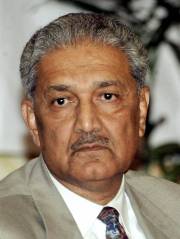 “That’s what we’ve always concluded. According to our seismic data, the yields were pretty low. But the devices clearly worked, and that’s the concerning part. Once you’ve succeeded in refining fuel to the point of sustaining fission and demonstrated the ability to trigger that process, the rest is all details – and those details are a lot more available than we’d like to think. We’ve got to assume that they bought every piece of Pakistani information A. Q. Kahn was willing to sell. And also that there wasn’t any information the bastard wasn’t willing to sell.”
“That’s what we’ve always concluded. According to our seismic data, the yields were pretty low. But the devices clearly worked, and that’s the concerning part. Once you’ve succeeded in refining fuel to the point of sustaining fission and demonstrated the ability to trigger that process, the rest is all details – and those details are a lot more available than we’d like to think. We’ve got to assume that they bought every piece of Pakistani information A. Q. Kahn was willing to sell. And also that there wasn’t any information the bastard wasn’t willing to sell.”
“I see.” The President thought he knew where this was going, and he didn’t like the destination.
“The other possibility is that the tests didn’t fizzle at all. We know the North hasn’t been able to produce much weapons-grade fuel from the reactor they have – maybe enough for six one kiloton bombs, tops. With the two tests we’ve monitored, they’ve therefore used up at least a third of their total stockpile of enriched uranium. They can’t afford to run more tests without losing the strategic value they gained by demonstrating that they’ve got a nuclear capability.
“But what if those weren’t proof of technology tests after all? And what if they were only half kiloton bombs? If so, what we detected might have been completely successful tests of smaller, more light-weight warheads. If that’s the case, they’ve demonstrated twice in a row that they can make a missile-deliverable warhead of dangerous size that works.”
Outside, it was starting to snow. Harrison wondered whether the President was aware of it as he stared out the window, tapping his teaspoon quietly on the tablecloth. Finally, the President asked, “What do we calculate the odds are of that being the case?”
“Well, Mr. President, as you know, there’s no country where we have less reliable intelligence to work with than North Korea. That means that just about everything we do have is by way of inference and conjecture, and not based on direct intelligence. So we’d be kidding ourselves if we even tried to come up with anything like a percentage estimate.”
The President turned and looked at him, slightly annoyed. “Okay, let me rephrase my question. When I walk into the Oval Office today, do I, or do I not have to take their wretched ‘Dear Leader’s’ threat seriously?”
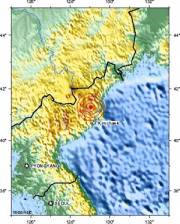 Harrison had expected this question, and for the last twelve hours had struggled with what he would say in response. After North Korea had followed its first missile test with a second only a month later, Harrison had divided his analysts into two teams: one to argue on the data for a credible nuclear threat, and one to contend that the North’s technology wasn’t yet capable of delivering a nuclear warhead to the U.S. He’d spent half of last night reading and re-reading the resulting position papers. When he finally went to bed he still hadn’t reached a conclusion.
Harrison had expected this question, and for the last twelve hours had struggled with what he would say in response. After North Korea had followed its first missile test with a second only a month later, Harrison had divided his analysts into two teams: one to argue on the data for a credible nuclear threat, and one to contend that the North’s technology wasn’t yet capable of delivering a nuclear warhead to the U.S. He’d spent half of last night reading and re-reading the resulting position papers. When he finally went to bed he still hadn’t reached a conclusion.
Harrison saw that it was snowing heavily now. The spectral branches of the bare trees on the White House lawn were tossing in the wind. Looking into the dark turbulence of the world outside, Harrison decided he had been resisting a conclusion he was not yet willing to accept. Not for the first time, he was grateful that his friend sat behind the desk in the Oval Office and not himself.
“I’m sorry, Henry. I think that you have to assume that we’ve got a real problem on our hands.”
The President tapped his teaspoon on the tablecloth a few more times, and then set it down neatly next to his plate. Harrison noticed that most of his eggs and bacon were uneaten.
“Well, that’s that, then,” his boss said quietly. He pushed a button on the phone on the table and a voice instantly answered.
“Yes, Mr. President?”
“Virginia, what times today can you open up for me without the press wondering what’s going on?”
There was a pause. “10 to 10:45, and 1:30 – 3:00, Mr. President.”
“Good. I’ll want a one-hour meeting of the National Security Council this afternoon. Do what you need to do to clear everyone’s schedule as much as possible. And I want to have that meeting somewhere where we won’t attract too much attention. Can you do that?”
“I’m sure we can work that out, Mr. President. I expect that many of the Council members are out of town, so we’ll need to video conference them in.”
“That’s great, Virginia. Thanks.”
He was reaching for the speakerphone button when Virginia spoke up again.
“Happy birthday, Mr. President!”
The President turned to give his old friend a tired smile before he replied.
“Yes, Virginia. Happy birthday to me.”
– 0000 – 0001 – 0010 – 0011 – 0100 – 0011 – 0010 – 0001 – 0000 –
The Alexandria Project, Chapter 21: What a Difference a Dong Makes!
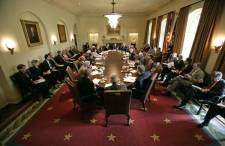 President Rawlings looked across the broad cabinet table somberly. How old was this particular piece of furniture, he wondered? How many presidents had sat exactly where he did today to decide whether to take a step closer to war? Could he decide as wisely? He grasped the edge of the table with both hands, as if to draw wisdom and strength from its smooth, solid weight.
President Rawlings looked across the broad cabinet table somberly. How old was this particular piece of furniture, he wondered? How many presidents had sat exactly where he did today to decide whether to take a step closer to war? Could he decide as wisely? He grasped the edge of the table with both hands, as if to draw wisdom and strength from its smooth, solid weight.But if the table had any wisdom to offer, it wasn’t sharing any today. So the President cleared his throat and the subdued chatter around the table rapidly subsided.
“Good morning. You all know the topic of today’s meeting, so let’s get started. General Hayes, please give us the aerial surveillance update.”
Brigadier General Fletcher Hayes had never attended a National Security Council meeting before, and he was determined not to show it. More of an academic than a field officer, he was as conscious as the President of the historical precedents for the presentation he was about to give. Who, he wondered, had delivered the aerial recon review to President Kennedy in this same room at the beginning of the Cuban Missile Crisis?
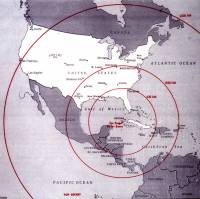 Hayes rose from his seat, and nodded to the four subordinates that were standing next to the empty easels placed in the corners of the room. Each assistant placed a four by six foot satellite photo on his or her easel.
Hayes rose from his seat, and nodded to the four subordinates that were standing next to the empty easels placed in the corners of the room. Each assistant placed a four by six foot satellite photo on his or her easel.Hayes began to speak. “The picture you see was taken at 1200 local time today by one of our satellites over North Korea. What you are looking at is Launch Pad 10 at the North’s main military launch facility. As you can see, there is a missile in position next to the gantry, and the area is clear of any supporting vehicles. From this we conclude that the missile is ready to go, except for fueling. In other words, it can become fully operational within approximately twelve hours of an order to initiate the launch sequence.”
On signal, the assistants placed a nearly identical picture on the easels.
“And this is a photo of a missile in a similar state of readiness on Launch Pad 12. The question is, what sort of missiles are we looking at?”
The General motioned once more to his assistants, and this time they placed a large diagram on the easels that displayed a series of increasingly larger rockets, together with a map with concentric circles centering on North Korea.
“Here you see the four largest known missiles in the arsenal of the North, from smallest to largest – the Scud C Upgrade, the Nodong, both in yellow, and the Taepodong 1 and Taepodong 2 – the two missiles in blue. The map in the upper right shows the presumed range of each launch vehicle. As you will note, the largest circle shows that the range of the Taepodong-2 missile, carrying a conventional nuclear warhead, would reach Alaska. With a lighter payload, we assume it could reach the Pacific Northwest.
“Now let’s return to our surveillance photos.” The General nodded to his assistants, and a new blow-up appeared on the easels.
“What you see on the left half of this display is Launch Pad 10 once again, but this time the photo was taken later on the same day, at 1645 local time – just before sunset. The picture you see on the right hand side was also taken just before sunset, but this picture was taken on April 4, 2012. The missile in this picture is the Taepodong-2 missile the North launched with partial success the next day.
“Now if you open the folder in front of each of you, you will find a diagram with the outlines of two multi-stage missiles, with the larger of the two superimposed over the smaller. These outlines were created to the same scale, and were produced by measuring the shadows that you see on the pictures on the easel after compensating for the change of seasons.”
“As you can tell from the scale on the left side of the diagram, the larger of the two missiles is about 20% taller than the smaller one. If you look carefully at the silhouettes, you will see that this difference results entirely from the extension of the second stage. The third stage appears to be unchanged, with no increase in the size of either the delivery or the payload sections.”
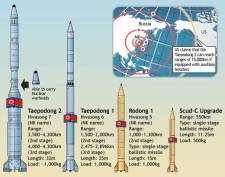 “Finally, you will note that the silhouette of the first stage of the larger missile is much broader, by reason of the addition of a booster rocket on each side of the main launch vehicle.”
“Finally, you will note that the silhouette of the first stage of the larger missile is much broader, by reason of the addition of a booster rocket on each side of the main launch vehicle.”“Our assumption is, therefore, that what we see on the launch pads now are indeed the Taepodong-3 missiles that Kim Jong-Il claimed a week ago he intended to target at the U.S.”
The General paused. “Are there any questions so far?”
The room was silent. Then the President spoke.
“General Hayes, do we believe that any of the components of the larger rocket are new?”
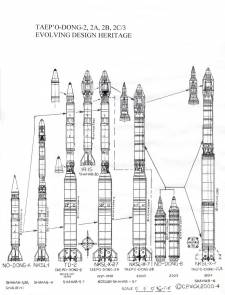 “Excellent question, sir. Unfortunately, for all practical purposes the answer is ‘no.’ The first and third stages appear to be identical to those of the Taepodong-2, while the larger second stage is also the same as the one used with the Taepodong-2, except with larger fuel and oxygen tanks made possible by the added thrust supplied by the booster rockets added to the launch configuration. Increasing the size of those components presents no new engineering challenges of any significance. And the size and shape of the booster rockets is an exact match to the solid fuel rockets the North has been successfully launching for years.”
“Excellent question, sir. Unfortunately, for all practical purposes the answer is ‘no.’ The first and third stages appear to be identical to those of the Taepodong-2, while the larger second stage is also the same as the one used with the Taepodong-2, except with larger fuel and oxygen tanks made possible by the added thrust supplied by the booster rockets added to the launch configuration. Increasing the size of those components presents no new engineering challenges of any significance. And the size and shape of the booster rockets is an exact match to the solid fuel rockets the North has been successfully launching for years.”“Have they successfully launched mixed solid and liquid fuel configurations before?”
“Yes, sir, they have.”
“Thank you General. Please proceed.”
Hayes nodded to his assistants.
“What you see superimposed over this map of North America are arcs that represent the ranges that we believe a missile of the size of the Taepodong-3 would have, based upon differing payload weights.”
The Council members peered especially intently at this map. The first arc approximately followed the line of the Rockies, while the second took in Chicago, St. Louis, Dallas, and Houston. The third arc included the entire United States, except for the bottom third of Florida.
“More specifically, these arcs relate to payloads equivalent to 4,000, 3,000, and 2,000 pounds in weight.”
The President spoke up again. “And how did you select those weights, General? Are they arbitrary, or do they have particular significance?”
The General chose his words carefully. “Mr. President, we were using a variety of educated guesses when we chose the weights for this particular purpose. Essentially, they represent a range of assumptions based upon the level of sophistication that the North Koreans may have achieved in the design of their nuclear weaponry as it correlates to weapon weight and force. If that sophistication is high, then the current weight of their nuclear warheads may be as much as half that of a crude device.”
“Depending upon which of those assumptions proves to be accurate, the arcs therefore represent the current capability of the North to deliver a 1 kiloton nuclear warhead to the continental U.S., assuming that their delivery vehicle operates to full design potential.”
“One last question, General. Have your people formed any opinion on the probable weight of the payload the third stage of these rockets is intended to carry, based on the available volume of the third stage?”
“Yes, Mr. President, they have.”
“And that opinion is?”
“Between 1800 and 2100 pounds, sir.”
“Thank you very much, General. I’m sure we’ll be inviting you to join us again soon.”
– 0000 – 0001 – 0010 – 0011 – 0100 – 0011 – 0010 – 0001 – 0000 –
Isn’t it time you read:
The Alexandria Project?
a Tale of Treachery and Technology
|
Remarkably accurate while consistently spellbinding: I ran across a reference to this book at a blog unrelated to the author, and after reading one chapter, bought the book
Great thriller: In the spirit of Vincent Flynn and Tom Clancy, this cyber-security thriller is a great read. Compelling characters, great detail and an an unsettlingly plausible scenario add up to a real page-turner.
Delightfully unpredictable! Updegrove has managed what many attempt but few can execute: a plot that is both credible and surprising….A great read – I can’t wait for the next one!
Strong characters and compelling plot: I read a lot of novels and this is a very good one. The characters are believable and engaging and the plot is compelling with several clever twists along the way….Highly recommended
Excellent and accessible techno-thriller: Updegrove…clearly knows the subject matter inside and out, but is too self-assured and smooth a writer to hide behind that insider’s knowledge….I look forward to Updegrove’s next book with great anticipation.
Great Read: This is a very well written, highly engaging story. The scary thing about it is that the entire plot is far too possible to come to life.
Fantastic! The Alexandria Project is a gripping novel of intrigue and suspense. The characters may be fictional, but we all know their real-life equivalents. The storyline may be fiction – but maybe not.
Read these and more 5 Star reviews at Amazon
|
The only part that’s fictional is that it hasn’t happened yet
Available Now for $2.99 or less
Buy at Amazon
Buy at iTunes Store
Buy at Barnes & Noble
|

 The President of the United States was treating himself to an early breakfast of bacon and eggs. And why not? If a Commander-in-Chief couldn’t ignore his personal physician’s orders on his seventieth birthday, why bother to have the job at all?
The President of the United States was treating himself to an early breakfast of bacon and eggs. And why not? If a Commander-in-Chief couldn’t ignore his personal physician’s orders on his seventieth birthday, why bother to have the job at all?  “The truth is, there are some new developments we’re watching closely. You’ll recall that the North tried to launch a satellite back in April of 2009. They used a three stage missile, and at least the third stage failed. The payload hit the ocean about 1300 miles down range. Of course, back home the regime claimed the launch was a complete success.”
“The truth is, there are some new developments we’re watching closely. You’ll recall that the North tried to launch a satellite back in April of 2009. They used a three stage missile, and at least the third stage failed. The payload hit the ocean about 1300 miles down range. Of course, back home the regime claimed the launch was a complete success.” “That’s what we’ve always concluded. According to our seismic data, the yields were pretty low. But the devices clearly worked, and that’s the concerning part. Once you’ve succeeded in refining fuel to the point of sustaining fission and demonstrated the ability to trigger that process, the rest is all details – and those details are a lot more available than we’d like to think. We’ve got to assume that they bought every piece of Pakistani information A. Q. Kahn was willing to sell. And also that there wasn’t any information the bastard wasn’t willing to sell.”
“That’s what we’ve always concluded. According to our seismic data, the yields were pretty low. But the devices clearly worked, and that’s the concerning part. Once you’ve succeeded in refining fuel to the point of sustaining fission and demonstrated the ability to trigger that process, the rest is all details – and those details are a lot more available than we’d like to think. We’ve got to assume that they bought every piece of Pakistani information A. Q. Kahn was willing to sell. And also that there wasn’t any information the bastard wasn’t willing to sell.” Harrison had expected this question, and for the last twelve hours had struggled with what he would say in response. After North Korea had followed its first missile test with a second only a month later, Harrison had divided his analysts into two teams: one to argue on the data for a credible nuclear threat, and one to contend that the North’s technology wasn’t yet capable of delivering a nuclear warhead to the U.S. He’d spent half of last night reading and re-reading the resulting position papers. When he finally went to bed he still hadn’t reached a conclusion.
Harrison had expected this question, and for the last twelve hours had struggled with what he would say in response. After North Korea had followed its first missile test with a second only a month later, Harrison had divided his analysts into two teams: one to argue on the data for a credible nuclear threat, and one to contend that the North’s technology wasn’t yet capable of delivering a nuclear warhead to the U.S. He’d spent half of last night reading and re-reading the resulting position papers. When he finally went to bed he still hadn’t reached a conclusion.  President Rawlings looked across the broad cabinet table somberly. How old was this particular piece of furniture, he wondered? How many presidents had sat exactly where he did today to decide whether to take a step closer to war? Could he decide as wisely? He grasped the edge of the table with both hands, as if to draw wisdom and strength from its smooth, solid weight.
President Rawlings looked across the broad cabinet table somberly. How old was this particular piece of furniture, he wondered? How many presidents had sat exactly where he did today to decide whether to take a step closer to war? Could he decide as wisely? He grasped the edge of the table with both hands, as if to draw wisdom and strength from its smooth, solid weight. Hayes rose from his seat, and nodded to the four subordinates that were standing next to the empty easels placed in the corners of the room. Each assistant placed a four by six foot satellite photo on his or her easel.
Hayes rose from his seat, and nodded to the four subordinates that were standing next to the empty easels placed in the corners of the room. Each assistant placed a four by six foot satellite photo on his or her easel. “Finally, you will note that the silhouette of the first stage of the larger missile is much broader, by reason of the addition of a booster rocket on each side of the main launch vehicle.”
“Finally, you will note that the silhouette of the first stage of the larger missile is much broader, by reason of the addition of a booster rocket on each side of the main launch vehicle.” “Excellent question, sir. Unfortunately, for all practical purposes the answer is ‘no.’ The first and third stages appear to be identical to those of the Taepodong-2, while the larger second stage is also the same as the one used with the Taepodong-2, except with larger fuel and oxygen tanks made possible by the added thrust supplied by the booster rockets added to the launch configuration. Increasing the size of those components presents no new engineering challenges of any significance. And the size and shape of the booster rockets is an exact match to the solid fuel rockets the North has been successfully launching for years.”
“Excellent question, sir. Unfortunately, for all practical purposes the answer is ‘no.’ The first and third stages appear to be identical to those of the Taepodong-2, while the larger second stage is also the same as the one used with the Taepodong-2, except with larger fuel and oxygen tanks made possible by the added thrust supplied by the booster rockets added to the launch configuration. Increasing the size of those components presents no new engineering challenges of any significance. And the size and shape of the booster rockets is an exact match to the solid fuel rockets the North has been successfully launching for years.”